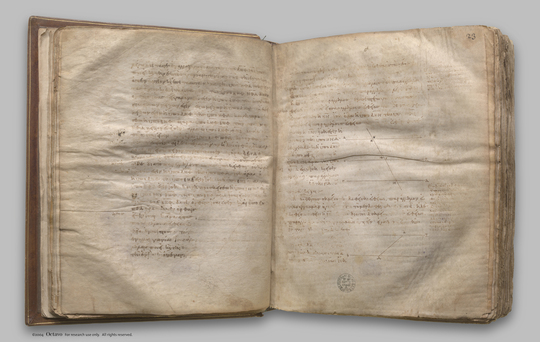index prev next | digilib folio 27

Through a given point to draw a straight line parallel to a given straight line.
| Διὰ τοῦ δοθέντος σημείου τῇ δοθείσῃ εὐθείᾳ παράλληλον εὐθεῖαν γραμμὴν ἀγαγεῖν. Ἔστω τὸ μὲν δοθὲν σημεῖον τὸ Α, ἡ δὲ δοθεῖσα εὐθεῖα ἡ ΒΓ: δεῖ δὴ διὰ τοῦ Α σημείου τῇ ΒΓ εὐθείᾳ παράλληλον εὐθεῖαν γραμμὴν ἀγαγεῖν. Εἰλήφθω ἐπὶ τῆς ΒΓ τυχὸν σημεῖον τὸ Δ, καὶ ἐπεζεύχθω ἡ ΑΔ: καὶ συνεστάτω πρὸς τῇ ΔΑ εὐθείᾳ καὶ τῷ πρὸς αὐτῇ σημείῳ τῷ Α τῇ ὑπὸ ΑΔΓ γωνίᾳ ἴση ἡ ὑπὸ ΔΑΕ: καὶ ἐκβεβλήσθω ἐπ' εὐθείας τῇ ΕΑ εὐθεῖα ἡ ΑΖ. Καὶ ἐπεὶ εἰς δύο εὐθείας τὰς ΒΓ, ΕΖ εὐθεῖα ἐμπίπτουσα ἡ ΑΔ τὰς ἐναλλὰξ γωνίας τὰς ὑπὸ ΕΑΔ, ΑΔΓ ἴσας ἀλλήλαις πεποίηκεν, παράλληλος ἄρα ἐστὶν ἡ ΕΑΖ τῇ ΒΓ. Διὰ τοῦ δοθέντος ἄρα σημείου τοῦ Α τῇ δοθείσῃ εὐθείᾳ τῇ ΒΓ παράλληλος εὐθεῖα γραμμὴ ἦκται ἡ ΕΑΖ: ὅπερ ἔδει ποιῆσαι. | Through a given point to draw a straight line parallel to a given straight line. Let A be the given point, and BC the given straight line; thus it is required to draw through the point A a straight line parallel to the straight line BC. Let a point D be taken at random on BC, and let AD be joined; on the straight line DA, and at the point A on it, let the angle DAE be constructed equal to the angle ADC [I. 23]; and let the straight line AF be produced in a straight line with EA. Then, since the straight line AD falling on the two straight lines BC, EF has made the alternate angles EAD, ADC equal to one another, therefore EAF is parallel to BC. [I. 27] Therefore through the given point A the straight line EAF has been drawn parallel to the given straight line BC. |